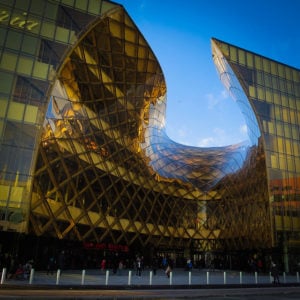Late last year, Daveed Gartenstein-Ross and Tadd Lahnert introduced the concept of Crisis Architecture. In their words:
“[Crisis architecture] incorporates integrated tactical, psychological, and technological security measures, while preserving the function and aesthetics of buildings to which these measures are applied. The focus of this paradigm is designing the built environment in a way that increases the likelihood that individuals will survive an active aggressor incident.” [emphasis added]
It’s tempting to dismiss this as “CPTED (crime prevention through environmental design) on steroids.” But Gartenstein-Ross’s and Lahnert’s “crisis architecture” is really fundamentally different from CPTED. They both seek to increase safety and security. One does so by changing how people interact with the place. The other does so largely by preventing unwanted interactions between people. They are complementary security strategies.

“Crisis Architecture” and the Origins of CPTED
CPTED (crime prevention through environmental design) is a proven low-cost, low-controversy strategy for increasing safety and preventing crime. In a 2000 meta-analysis published in the American Journal of Preventive Medicine, Carri Casteel and Corinne Peek-Asa examined the effectiveness of CPTED initiatives in the United States. They found CPTED measures correlated to a 30 to 84 percent decrease in robberies.
CPTED grew out of Jane Jacobs’ 1961 urban design treatise, The Death and Life of American Cities. Jacobs’ most enduring contribution to urban design has been the notion of “eyes on the street“:
“There must be eyes upon the street,” Jacobs wrote. “Eyes belonging to those we might call the natural proprietors of the street. The buildings on a street, equipped to handle strangers and to ensure the safety of both residents and strangers, must be oriented to the street.” [emphasis added]
This idea—that design can both communicate and reinforce the rightful occupant’s ownership of a place—played a large role in transforming major North American urban centers in the last quarter of the 20th Century. Cities like New York, Toronto, and Chicago are livable and highly sought-after specifically because urban designers applied Jacobs’ ideas.
Later city planners (notably Oscar Newman) developed these ideas further:
If the built environment can inspire the rightful occupants to care for and maintain their territory (thus increasing safety), it can also disadvantage interlopers and criminals.
Thus, CPTED (crime prevention through environmental design) was born.
The Three Core Components of CPTED
CPTED relies on three core components:
- Natural surveillance. Make it easy for the “natural proprietors” to see what’s going on and note anything out of the ordinary. These are the so-called “eyes on the street” aspects of the design.
- Natural access control. Create real and perceived barriers that inhibit the ability or desire to trespass (e.g., fences, gates, thorny hedges, etc.)
- Territorial reinforcement. Use design elements and upkeep to reinforce territorial boundaries and communicate vigilance (e.g., tidy sidewalks, bold signage, landscaping, lighting, etc.)
Each of these core components includes “natural” (design-based), “mechanical” (technology- and device-based), and “organizational” (personnel- and management-based) aspects. For example, having many exterior windows as a “natural” way to increase natural surveillance around your building. Adding cameras would be a “mechanical” measure to increase surveillance. Keeping all of the windows extremely clean and clear of decorations or hangings that might obscure the view offers an “organizational” improvement to your surveillance capabilities. This also enhances your territorial reinforcement, as it makes it clear that the building is being monitored and cared for.
Check out our Ultimate Architect’s Resource Kit
The Eight Principles of Crisis Architecture
Crisis architecture is more complex and more nuanced. Gartenstein-Ross and Lahnert list eight core principles:
- Enable Creation of Distance: “numerous connecting hallways … and multiple staircases between floors … facilitate short transit times … [and] allow potential victims to quickly flee”
- Allow Safe Exit from Numerous Points in the Building: “numerous exits … both prevent individuals from becoming trapped … and ease … evacuating congested spaces”
- Incorporate Angles to Limit a Shooter’s Line of Sight: “eschew long straight hallways where people have no place to avoid being seen, and rooms where most of the floor area is directly visible from the door”
- Provide Adequate Cover and Concealment: “design elements that provide cover and concealment … facilitate the creation of distance as people move to exit a facility, and provide protection for those who shelter in place”
- Enable Rapid Hardening of a Facility: “the majority of casualties in mass shooter incidents are inflicted in a short amount of time after the attack begins … rapid hardening of a facility can alleviate this dynamic”
- Implement “Human-Centered Design” Concepts: “work with human instincts to maximize safety in a moment of excessive adrenaline and minimal rational thought”
- Training and Design Need to be Mutually Supporting: “if an organization’s active shooter protocol is to shelter in place, the spaces where they are supposed to do so should be built to withstand … an attack”
- Integrate Systems to Increase the Situational Awareness of First Responders: “install systems that decrease the amount of time it takes for first responders to gain situational awareness”
In CPTED, the designed environment seeks to subtly influence behaviors by rightful occupants, visitors, and trespassers. In Crisis Architecture, the designed environment seeks to actively shield rightful occupants and obstruct assailants.
New Ideas Require Careful Consideration
As is the case with any new approach, “crisis architecture” has yet to prove itself out in the real world. But it addresses some core issues left unexamined by CPTED—which is a broad crime prevention strategy, rather than a narrow defensive strategy.
For example, limiting shooter sight lines and providing adequate cover has proven extremely critical in workplace and school shootings. During the Parkland School shooting, the long broad hallways (packed with students due to the attacker having pulled a fire alarm) and open classroom design made it possible for the attacker to select all of his targets with minimal effort. Likewise, inadequate cover contributed to casualties during the 2015 San Bernardino workplace shooting. Several people in other rooms, invisible to the shooters, were injured when stray bullets penetrated standard doors and walls.
That said, proceed with caution. Every design choice should give building occupants every opportunity to avoid or prevent an attack—not just survive one. For example, we always want building occupants to have many choices in how to make a rapid retreat (points #1 and #2 above). But we also know that this can lead to confusing floor plans. Alongside a defensible floor plan, we want to be sure that we design good information systems that support wayfinding (even under the most chaotic conditions).
Taking Thoughtful Security in New Directions
“We’re always really glad to see people thinking deeply and in new ways about safety and security,” says Total Security Solutions CEO Jim Richards. “And we’re happy to share our experience and expertise—what we’ve seen work, and where designs go astray.”
“What this comes back to is really deeply understanding your threats and risks, and taking an ‘all-hazards’ approach to increasing safety for your people. For example, this advice about multiple entrances and exits. With certain kinds of threats and certain kinds of facilities, that’s perfect. But if you are concerned about other risks—like coronavirus, or schools where the daily threats have more to do with bullying or drugs or family abduction—the benefit of multiple entrances and exits can easily be outweighed by the much larger benefit of funneling all visitors through a single main entrance where they can be screened for fevers, IDs can be checked, and so on. But that said, as a company, we always advocate for these thoughtful, ‘all-hazards’ approaches to physical security. You take a comprehensive look at your challenges and we’ll help you come up with a comprehensive system for addressing them.”


